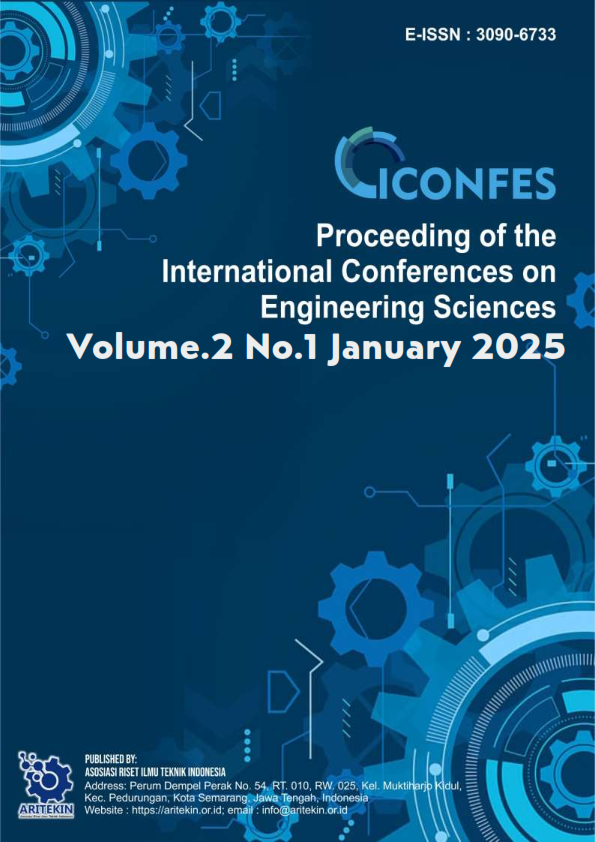Development of Sustainable Concrete Utilizing Rice Husk Ash and Palm Oil Fuel Ash as Supplementary Cementitious Materials
Keywords:
Sustainable concrete, rice husk ash, palm oil fuel ash, cementitious materials, green infrastructure, IndonesiaAbstract
The construction industry in Indonesia faces challenges in finding sustainable materials for concrete production. This paper investigates the potential of rice husk ash (RHA) and palm oil fuel ash (POFA) as alternative supplementary cementitious materials (SCMs) in concrete. Both RHA and POFA are abundant agricultural by-products in Indonesia. Laboratory tests indicate that their incorporation enhances the compressive strength, durability, and sustainability of concrete. The findings highlight the dual benefit of reducing industrial waste and creating eco-friendly construction materials, thus contributing to the development of green infrastructure in Indonesia.
References
Awal, A. S. M. A., & Nguong, S. K. (2013). A short-term investigation on high volume palm oil fuel ash (POFA) concrete. Proceedings of the 3rd International Conference on Civil Engineering and Building Materials.
Bui, D. D., Hu, J., & Stroeven, P. (2005). Particle size effect on the strength of rice husk ash blended gap-graded Portland cement concrete. Cement and Concrete Composites, 27(3), 357-366.
Chindaprasirt, P., & Rukzon, S. (2008). Strength, porosity, and corrosion resistance of ternary blend cement mortars containing portland cement, rice husk ash, and fly ash. Construction and Building Materials, 22(8), 1601-1606.
Foo, K. Y., & Hameed, B. H. (2009). Utilization of rice husk ash as a low-cost material for removal of contaminants in wastewater. Journal of Hazardous Materials, 172(2-3), 523-531.
Ganesan, K., Rajagopal, K., & Thangavel, K. (2008). Rice husk ash blended cement: Assessment of optimal level of replacement for strength and permeability properties of concrete. Construction and Building Materials, 22(8), 1675-1683.
Islam, M. N., Islam, M. A., & Islam, M. S. (2014). Strength and durability properties of concrete with rice husk ash as a partial replacement of cement. Journal of Civil Engineering and Management, 20(1), 1-8.
Muthusamy, K., & Zamri, N. (2016). Exploring the potential of palm oil fuel ash as a supplementary cementitious material in concrete. Journal of Cleaner Production, 112, 763-771.
Ramezanianpour, A. A., Mahdikhani, M., & Ahmadibeni, G. (2009). The effect of rice husk ash on mechanical properties and durability of sustainable concrete. International Journal of Civil Engineering, 7(2), 83-91.
Rukzon, S., & Chindaprasirt, P. (2012). Use of palm oil fuel ash to improve chloride and corrosion resistance of concrete. Construction and Building Materials, 29, 616-621.
Safiuddin, M., West, J. S., & Soudki, K. A. (2010). Properties of freshly mixed self-consolidating concrete incorporating rice husk ash as a supplementary cementing material. Construction and Building Materials, 24(11), 2030-2037.
Sata, V., Jaturapitakkul, C., & Kiattikomol, K. (2007). Influence of pozzolan from various by-product materials on mechanical properties of high-strength concrete. Construction and Building Materials, 21(7), 1589-1598.
Tajunnisa, R., & Abdullah, M. M. A. B. (2018). Effect of palm oil fuel ash on the workability and strength of concrete for sustainable construction. Materials Science Forum, 929, 243-248.
Tonnayopas, D., Tangchirapat, W., & Jaturapitakkul, C. (2006). Effect of rice husk ash on strength and durability of cementitious materials. Journal of Materials in Civil Engineering, 18(5), 646-651.
Zain, M. F. M., Islam, M. N., Mahmud, F., & Jamil, M. (2011). Production of rice husk ash for use in concrete as a supplementary cementitious material. Construction and Building Materials, 25(2), 798-805.
Zarina, Y., Awal, A. S. M. A., & Hassan, M. Z. (2016). The effectiveness of palm oil fuel ash in preventing chloride penetration in concrete. Construction and Building Materials, 128, 272-283.
Downloads
Published
Issue
Section
License
Copyright (c) 2024 The International Conferences on Engineering Sciences

This work is licensed under a Creative Commons Attribution-ShareAlike 4.0 International License.





